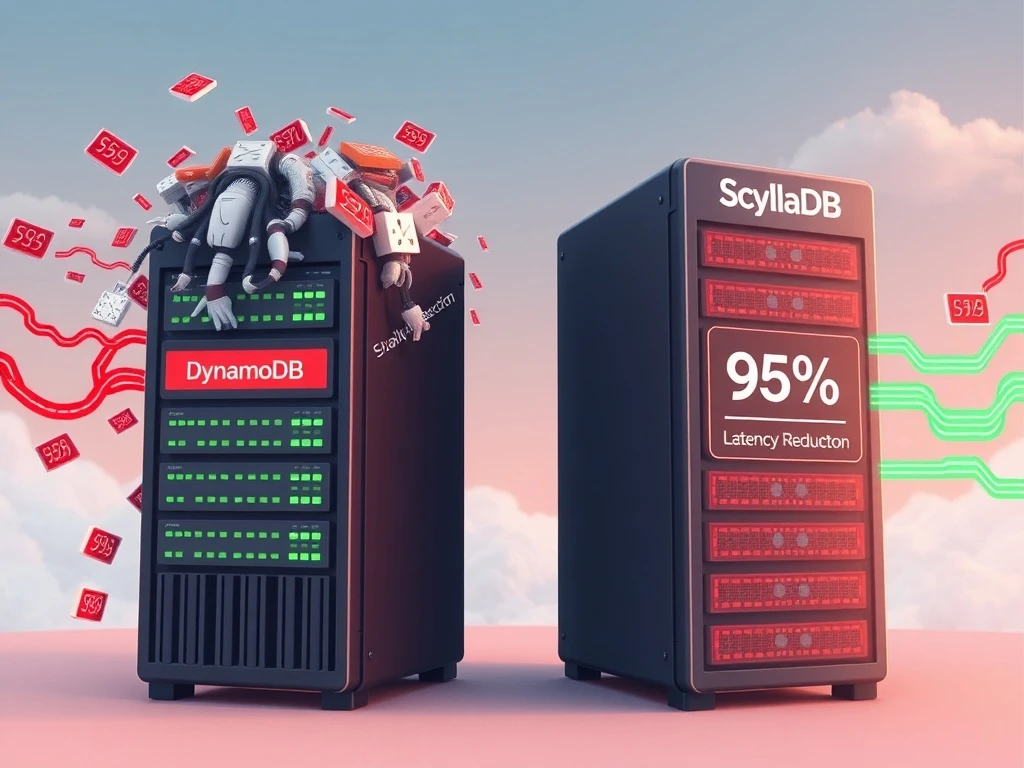DynamoDB Exodus: ScyllaDB Unlocking Dramatic 95% Latency Reduction and Cost Efficiency

In the rapidly evolving landscape of cloud computing, businesses are constantly seeking solutions that offer both peak performance and cost efficiency. A significant shift is currently underway, as many enterprise teams are initiating a strategic database migration away from Amazon Web Services’ DynamoDB. The driving force behind this exodus? The compelling advantages offered by alternatives like ScyllaDB, which promises not only a dramatic 95% reduction in latency but also substantial savings in cloud costs. This trend reflects a broader industry movement towards more flexible, high-performance, and economically viable database solutions.
Why Are Teams Abandoning DynamoDB?
For years, Amazon DynamoDB stood as a dominant force in the NoSQL database market, lauded for its managed simplicity and scalability. However, as enterprise needs have grown more complex and cost pressures intensified, its limitations have become increasingly apparent. Teams are encountering several pain points that prompt them to seek alternative solutions:
Fixed Pricing Model: While seemingly straightforward, DynamoDB’s fixed pricing can become prohibitively expensive, especially at scale. As data volumes and request rates grow, costs can spiral, leading to unexpected budget overruns. This lack of granular control over expenditure is a major concern for finance-conscious organizations.
Performance Inefficiencies: Despite its reputation for scalability, DynamoDB has reportedly struggled to meet the demanding performance requirements of modern applications, particularly concerning tail latency. This can directly impact user experience in real-time applications like e-commerce, gaming, and analytics.
Limited Multi-Cloud Flexibility: In an era where vendor lock-in is a significant concern, DynamoDB’s tightly integrated nature within the AWS ecosystem restricts multi-cloud or hybrid-cloud deployment strategies. Organizations increasingly desire the flexibility to deploy their databases across various cloud providers or on-premises to optimize for cost, performance, and resilience.
Evolving Enterprise Needs: The rigidity of some managed services, including DynamoDB, can hinder agile development and adaptation to rapidly changing business requirements. Developers seek more control and customization options that allow for quicker iteration and innovation.
The Rise of ScyllaDB: A Solution for Modern Workloads
Amidst DynamoDB’s challenges, ScyllaDB has emerged as a preferred replacement, addressing many of these critical pain points. Built for extreme performance and efficiency, ScyllaDB offers a compelling suite of advantages that resonate with development teams and IT leaders alike:
Unmatched Latency Reduction: A key highlight is ScyllaDB’s ability to deliver a remarkable 95% reduction in tail latency compared to DynamoDB. This translates directly into a superior user experience for applications requiring real-time data access and processing, from financial trading platforms to IoT analytics.
Significant Cost Efficiency: By optimizing resource utilization and offering a more flexible licensing model (Apache 2.0), ScyllaDB enables organizations to achieve substantial savings in cloud costs. Its ability to handle more operations per server means fewer instances are needed, driving down infrastructure expenses.
Enhanced Scalability and Performance: ScyllaDB is engineered for high throughput and low latency at scale. Its shard-per-core architecture fully utilizes modern CPUs, providing superior NoSQL performance that can easily handle petabytes of data and millions of operations per second.
Cloud-Agnostic Deployment: Unlike DynamoDB, ScyllaDB offers true cloud-agnostic deployment options. Teams can deploy it on any cloud (AWS, Azure, GCP, etc.), on-premises, or in hybrid environments, providing the multi-cloud flexibility essential for avoiding vendor lock-in and optimizing infrastructure choices.
Apache Cassandra Compatibility: ScyllaDB is API-compatible with Apache Cassandra, a widely adopted NoSQL database. This compatibility is a game-changer, allowing teams to repurpose existing codebases and leverage their Cassandra expertise without a complete overhaul of their infrastructure or applications.
Navigating the Database Migration Journey
The decision to switch database platforms is not taken lightly, but the benefits of moving from DynamoDB to ScyllaDB are proving too significant to ignore. The migration trend reflects a strategic realignment within organizations to optimize cloud expenditures and achieve greater architectural flexibility. Companies are increasingly prioritizing solutions that offer open-source capabilities and allow for greater control over their data infrastructure.
For teams considering this database migration, ScyllaDB’s emphasis on compatibility with Apache Cassandra is a major advantage. It means that while they are adopting a new, high-performance database, they are not starting from scratch. Existing tools, drivers, and application code designed for Cassandra can often be reused with minimal modifications, significantly reducing the complexity and risk associated with such a move.
Significant Savings: Optimizing Cloud Costs with ScyllaDB
One of the most compelling arguments for adopting ScyllaDB is its profound impact on cloud costs. The operational efficiency of ScyllaDB translates directly into tangible financial benefits:
Fewer Servers, Same Workload: ScyllaDB’s ability to achieve higher throughput and lower latency per node means that fewer servers are required to handle the same workload compared to other NoSQL databases. This reduction in server count directly lowers infrastructure costs.
Reduced Operational Overhead: With its self-tuning capabilities and robust architecture, ScyllaDB can reduce the need for constant manual intervention and optimization, leading to lower operational expenditures (OpEx) for database administration teams.
Predictable Scaling: Unlike some managed services where costs can fluctuate unpredictably with usage spikes, ScyllaDB’s predictable performance characteristics allow for more accurate capacity planning and cost forecasting, giving businesses better control over their budgets.
Boosting NoSQL Performance: The Latency Advantage
Performance metrics, especially latency, are crucial for modern applications. The 95% latency reduction achieved by ScyllaDB is not just a technical specification; it directly impacts the end-user experience. In applications where every millisecond counts, such as real-time analytics, online gaming, and high-frequency trading, superior NoSQL performance can be a competitive differentiator. Lower latency means:
Faster page load times for e-commerce sites, leading to higher conversion rates.
More responsive user interfaces in interactive applications.
Quicker data processing for real-time dashboards and analytics.
Improved overall system responsiveness and reliability under heavy loads.
This focus on raw performance, combined with its cost-effectiveness and flexibility, positions ScyllaDB as a formidable player in the NoSQL market, challenging the long-standing dominance of services like DynamoDB.
The analysis suggesting DynamoDB’s waning dominance among developers prioritizing cost efficiency and architectural flexibility highlights a broader industry shift. As organizations continue to seek optimization and control over their cloud infrastructure, platforms like ScyllaDB are likely to gain further traction, signaling a potential realignment of the NoSQL database market towards more modular, open-source, and performance-driven solutions. The future of cloud databases appears to be one where customization, efficiency, and freedom from vendor lock-in are paramount.
Frequently Asked Questions (FAQs)
Q1: Why are companies moving away from DynamoDB?
Companies are moving away from DynamoDB primarily due to its fixed pricing model becoming expensive at scale, performance inefficiencies, particularly concerning tail latency, and limited flexibility for multi-cloud or hybrid-cloud deployments. The desire to avoid vendor lock-in and optimize cloud expenditures also plays a significant role.
Q2: What advantages does ScyllaDB offer over DynamoDB?
ScyllaDB offers several key advantages, including a dramatic 95% reduction in tail latency, significant cost efficiencies due to better resource utilization, enhanced scalability and NoSQL performance, cloud-agnostic deployment options, and compatibility with Apache Cassandra, which simplifies database migration.
Q3: Is ScyllaDB open-source?
Yes, ScyllaDB is open-source and licensed under Apache 2.0. This open-source nature provides greater transparency, community support, and flexibility for organizations to adapt the database to their specific needs without proprietary restrictions.
Q4: How does ScyllaDB reduce cloud costs?
ScyllaDB reduces cloud costs by requiring fewer servers to handle the same workload due to its superior performance and efficiency. Its optimized architecture means higher throughput per node, leading to lower infrastructure expenses and potentially reduced operational overhead.
Q5: What is tail latency and why is its reduction important?
Tail latency refers to the latency experienced by the slowest percentage of requests (e.g., the 99th percentile). A significant reduction in tail latency, like ScyllaDB’s 95% improvement, is crucial because it ensures a consistently fast and responsive user experience, even during peak loads. This is vital for applications requiring real-time interactions, such as e-commerce, gaming, and financial services.









